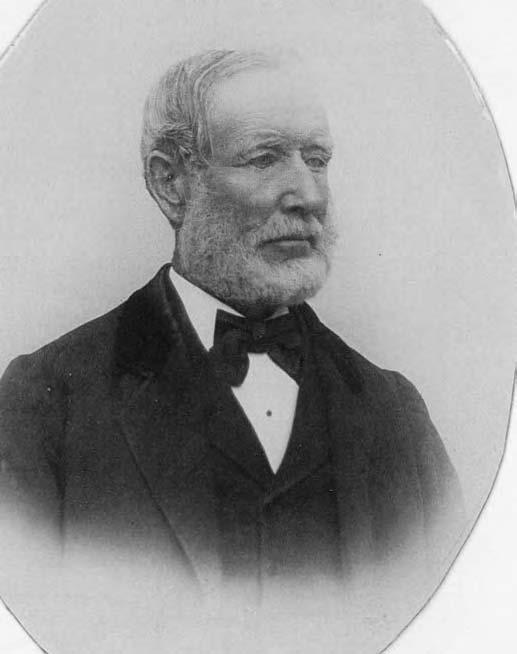
22 minute read
Contemporary Navajo Baskets on the Utah Reservation
Contemporary Navajo Baskets on the Utah Reservation
By CAROL EDISON
During the last three decades, in a remote region of the Navajo reservation in southeastern Utah, an art form long believed to be extinct has re-emerged, resulting in the development of one of the most innovative forms of community-based art in recent history. Working from the ancient form and design of ceremonial wedding baskets, a handful of Navajo artists, living in and around Monument Valley, have developed a new style of basket—the story basket—that visually depicts ancient Navajo legends and myths. While some baskets are designed around mythological characters, images and symbols and others feature symbolic or abstract designs, all merge oral traditions with material culture and create a visual representation and reminder of Navajo values and beliefs.
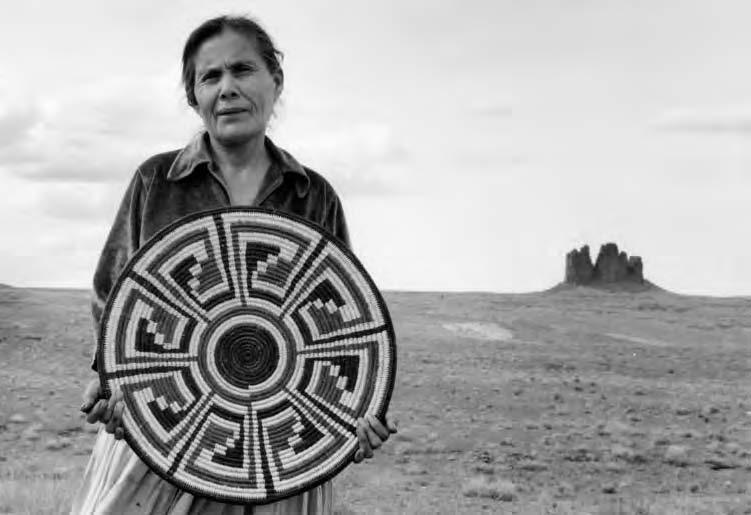
Navajo weaver Mary Holiday Black,Mexican Hat (1994). BELOWLEFTTO
ALL PHOTOS BY THE AUTHOR AND COURTESY OF THE ARTS COUNCIL UNLESS OTHERWISE NOTED

Butterflies basket by Jonathan Black (2005).
STATE FOLK ART COLLECTION
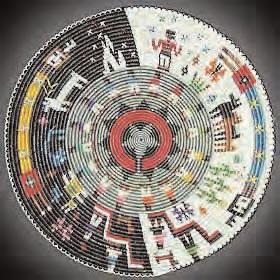
Collage basket by Peggy Rock Black (2005).
SIMPSON FAMILY COLLECTION

Home of the Butterflies by Mary Holiday Black (1995).
STATE FOLK ARTS COLLECTION
Much of this artistic activity is the product of a cluster of families who have lived for generations atop Douglas Mesa, a relatively isolated area in Monument Valley. Unbeknownst even to some of their northern reservation neighbors, the Bitsinnies, Blacks, Johnsons and Rocks had quietly continued to make ceremonial baskets long after basketry died out in other parts of the reservation. Perhaps this was because of the abundance of medicine men in this remote and very traditional area or perhaps because basketry materials grow relatively nearby. Whatever the reason, they continued to teach their children to weave ceremonial baskets, preserving an important link between past generations and those living in the twenty-first century. Today their basketry not only functions as it always has in ceremonies within the community, but is also known internationally as one of the most innovative and vibrant forms of contemporary Indian art.

Goshute weaver Evelyn Pete with her infant cradle (1996).
Utilitarian Baskets

Utilitarian gathering and winnowing baskets by Goshute weaver Molley McCurdy (1986).
Humans have always needed containers to transport and store food, tools, clothing and even infants, and in pre-industrial cultures, baskets often filled this need. But as the products of the Industrial Revolution reached remote native lands, traditional gathering, cooking and storage baskets made from locally gathered materials were gradually replaced with buckets, canteens, plates, cups and pots made of metal, ceramic and glass. Some basket forms became scarce and soon began to disappear. In Utah, knowledge of some of these older forms still exists within the Goshute Tribe as well as among the Navajo Tribe, where two forms of baskets, used specifically for ceremonial purposes, survive. Today the jugshaped basket, coated inside and out with pine pitch, and the tray-shaped basket, with the distinctive red, black and white design known as the wedding basket, are still being produced for use at ceremonies within the community.

Jeannie Bitsinnie Begay, Navajo weaver, Monument Valley (1995).
Ceremonial Baskets
Just as basket production was declining on the Navajo Reservation, other forms of traditional art were on the rise. The same trading posts that brought modern containers to the reservation opened up the outside market to Navajo-made goods, especially the popular wool rugs. Soon the lure of trade goods or cash for rugs and the fact that the production of ceremonial basketry was governed by formal rules and taboos, led most weavers to focus on rug weaving. But the need for ceremonial baskets remained strong and neighboring Ute and Paiute weavers, not subject to the same taboos as the Navajos, soon produced most of the ceremonial baskets needed by the Navajos. They sold or traded them to trading posts where they were then traded or sold to Navajo patients or medicine men, creating a rotation of baskets within communities that required fewer baskets and fewer weavers despite a growing population. At that point, most observers agree that Navajo basketry had basically died out and that the well-known red, black and white Navajo wedding basket, was the product of non- Navajo weavers.

Wedding basket by Paiute/Ute Mountain Ute weaver Lola Mike (1988).
STATE FOLK ARTS COLLECTION

Double wedding basket by Paiute/Ute Mountain Ute weaver Virginia Goodman (1989).
STATE FOLK ARTS COLLECTION

Double wedding basket by Ute Mountain Ute weaver Susan Whyte (ca.1980).
STATE FOLK ARTS COLLECTION
There are numerous interpretations for the meaning of the red, black and white Navajo wedding basket pattern. Some say the white center of the wedding basket portrays either Mother Earth or the beginning of the life; the black stepped terraces either clouds or mountains; and the red circular band either sunrays or a rainbow. The break in the circular pattern, used to orient the basket in the ritually appropriate easterly direction, is sometimes said to symbolize the emergence from the underworld at the time of creation as well as the entrance through which the Holy People come and go. Most agree the design in some way symbolizes the journey through life and many consider the act of weaving a ceremonial basket, from the center outward, to parallel that journey while building harmony and balance between the weaver and her surroundings. Of great ceremonial significance to the Navajo for many generations, this distinctive design is now in much wider use, and has been incorporated into beadwork, textiles and paintings both within and outside the tribe. For many, native and non-native alike, this design has come to symbolize contemporary Native American identity.
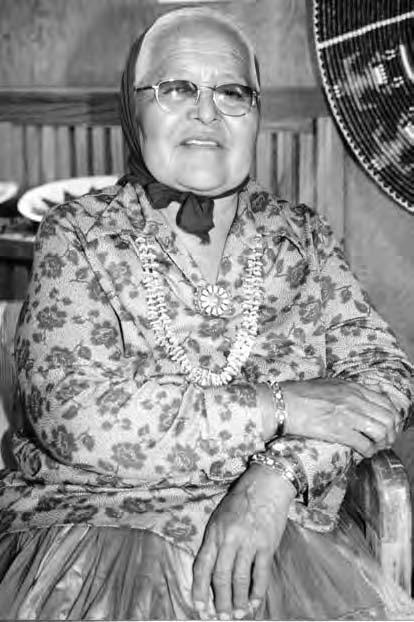
Etta Rock, Navajo ceremonial jug weaver, Bluff (2004).

Minnie Dick, Shoshone weaver, harvesting willow, Lee, Nevada (1980).

Section of basket by Kee Bitsinnie (1990).
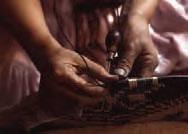
The hands of Mary Holiday Black weaving sumac, Mexican Hat (1994).
The Weaving Process

Sally Black, Navajo weaver, splitting sumac, Monument Valley (1995).
Much of the work and time required to make baskets is spent gathering and preparing the willow, or young stalks of sumac (Rhus trilobata), that grows near water and is hard to find in the desert. Interestingly, the banks of Utah’s Green River have long been a source for local Paiute, Ute and Navajo weavers contributing, perhaps, to the maintenance of basket-making skills in this area. After harvesting, a portion of the willow is split three ways, by holding the end of the willow with the teeth while pulling it apart with both hands, producing three thin strips or splints, ready to be trimmed, de-barked and sometimes dyed with vegetable or commercial dyes. The actual weaving requires coiling together several un-split willows, called rods, to create a shape that spirals outwards, counterclockwise from the center. Then using an awl or ice pick to punch a path through the coiled rods, the weaver inserts the splints of thin, peeled and dyed willow, tightly wrapping them around two layers of rods, moving from the center outwards. Ultimately, it is this repeated process of binding rods together with strips or splints of willow that produces the basket.

Wedding basket by Paiute/Ute Mountain Ute weaver Stella Eyetoo (1989).
STATE FOLKS ARTS COLLECTION, PHOTO BY HERRIDGES & ASSOCIATES

Bowl-shaped modified wedding basket with human figures by Paiute/Ute Mountain Ute weaver Stella Eyetoo (ca.1980).
SIMPSON FAMILY COLLECTION

Modified wedding basket with eagle by Ute Mountain Ute weaver Nedra Ketchum (ca.1980).
SIMPSON FAMILY COLLECTION
The Transitional Process

Stella Eyetoo and her daughter, Virginia Goodman, Paiute/Ute Mountain Ute weavers, White Mesa (1989).

Rachel Eyetoo,Ute Mountain Ute weaver,White Mesa (1988).
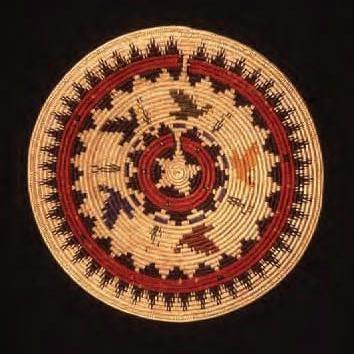
Modified wedding basket with ducks by Navajo weaver Anderson Black (1993).
Although it is difficult to pinpoint exactly when basket weavers in southeastern Utah first began modifying ceremonial baskets by adding figures and other images to the distinctive red, black and white design, it appears that sometime during the1950s Ute and Paiute weavers from the Ute Mountain Ute Reservation, in the community of White Mesa just south of Blanding, were doing precisely that. Two decades later, trader William Simpson, remembering having seen weavers working on figurative baskets as a young man living in Bluff, began asking local Ute weavers from White Mesa to bring him baskets with those designs. Though most of their baskets continued to feature the traditional ceremonial design in order to meet the needs of the local Navajo market, some weavers included or featured other images, often animals or people, providing baskets for the growing tourist market in the area. Without knowing it, they were taking the first steps in the development of a brand new style of basket that would ultimately be recognized throughout the Indian art world and
Exploration

Oversized ceremonial baskets by Mary Holiday Black displayed at Twin Rocks Trading Post,Bluff.
In the 1970s a burgeoning Indian art market led traders like Virginia “Chin” Smith from Oljato near Navajo Mountain as well as William Simpson in the Blanding-Bluff area to recognize the inherent artistry of traditional baskets and encourage native weavers to produce baskets that would appeal to buyers beyond the local Navajo market. While Simpson encouraged the Utes to once again include animal and human figures in their baskets, Virginia Smith used photographs of art from other cultures to stimulate Navajo weavers. She showed them prehistoric pottery and rock art from the ancient Anasazi and Mimbres who had lived in the region and contemporary designs from neighboring Apache, Hopi, Paiute, Pima and Papago (now Tohono O’odham) tribes. A few Navajo weavers became interested and began to include these geometric and pictorial images in their work. During this period, some Navajo weavers also expanded upon tradition by modifying the basic ceremonial design, just like neighboring Ute and Paiute weavers had done before them.They added birds, deer, butterflies and rabbits to the familiar red, black and white ceremonial basket, leaving elements of the traditional designs adjacent to images of animals and humans. At least one weaver, Mary Holiday Black, also experimented by stretching the technical aspects of basket weaving. She gathered and processed local plants, producing vegetable dyes to give her baskets more traditional colors. She also experimented with size, weaving ceremonial-style trays and traditional jug shapes in both miniature sizes and in sizes up to three or four times too large for conventional use.

Basket with does by Navajo weaver Eleanor Cly Rock (ca.1980).
SIMPSON FAMILY COLLECTION

Wedding basket with horses made using vegetable dye by Mary Holiday Black (ca.1975).
SUSAN MCCREEVY COLLECTION, PHOTO BY ROD HOOK

Set of tray and bowl shaped baskets by Elsie Holiday (1995).
SIMPSON FAMILY COLLECTION

Mary Holiday Black,Mexican Hat (1994).
Emergence of the Tradition

Basket with butterflies and wedding basket elements by Navajo weaver Sally Black (ca.1980).
SIMPSON FAMILY COLLECTION

Modified ceremonial bowl-shaped basket with horse heads by Navajo weaver Mary Holiday Black (2003).
SIMPSON FAMILY COLLECTION

Basket with rabbits and wedding basket elements by Navajo weaver Jeannie Bitsinnie Begay (ca.1986).
SIMPSON FAMILY COLLECTION

Eleanor Cly Rock,Navajo weaver,Douglas Mesa (1994).

Rainbow Yei basket by Navajo weaver Mary Holiday Black (ca.1980).
SIMPSON FAMILY COLLECTION

Evelyn Rock Cly, Navajo weaver, Mexican Hat (1994).
Having expanded her imagery to include pictorial and geometric designs from other native cultures, and having explored many of the technical aspects of basketry, sometime during the late 1970s, Mary Holiday Black embarked on a new direction. Encouraged by local traders and stimulated by the reaction of the marketplace, she started looking for other ways, closer to home, to further develop her art. An accomplished rug weaver, Mary easily transferred geometric rug designs into her baskets.Then, just as a number of rug weavers had done a few decades earlier, she began incorporating into her work the sacred images and designs inspired by the prayers and rituals of medicine men.
Before long, Mary’s baskets included representations of the Ye’ii — those sacred beings sent by the gods to help and heal the People and keep balance in the world. Though the use of these sacred images made some of her Navajo neighbors in her very traditional area uncomfortable, Mary persisted, trying to alleviate any bad consequences by regularly participating in ceremonies designed to maintain balance with her surroundings. Before long, she was not simply weaving symbolic or sacred images, but carefully combining several images that naturally went together, to depict traditional stories or ceremonies. The result of her courage and creativity was the development of a totally new, contemporary Navajo art form, the Navajo story basket, that visually depicts Navajo legends and beliefs, sharing them with both a younger often less traditional Navajo generation, and an eager outside audience interested in glimpsing Navajo culture through art.
One of the first baskets to actually tell a story depicted the fire dance, an ancient all-night Navajo ceremony that has not been performed regularly for many years but was originally part of the lengthy nine-day Hail Chant, designed to demonstrate the power of the medicine man. In the same way that dancers participating in this ceremony alternate throughout the night, the basket features dancers alternating with the flaming sagebrush that lights their way. Perhaps most importantly, through this work of art, images from an almost extinct Navajo ceremony have been preserved and can be experienced by everyone.


Bonnie Bitsinnie, Navajo weaver, Bluff (1995).

Coyote Woman basket by Navajo weaver Lorraine Black (1994).
SIMPSON FAMILY COLLECTION
Mary’s courage in using sacred imagery in her work certainly influenced the next generation of weavers who include her four daughters and four of her seven sons. Her daughter Lorraine’s playful rendition of the non-existent Coyote Woman illustrates the imagination and creativity Mary’s courage unleashed. In 1995, Mary was recognized for her contributions to Navajo basketry when she received a National Heritage Fellowship from the National Endowment for the Arts.
Flowering of the Tradition

Changing Bear Woman Basket Sally Black, eldest daughter of Mary Holiday Black, wove this intricate story basket depicting Changing Bear Woman who married Coyote after he killed a giant to win her hand. It illustrates how her brothers, though unhappy to hear of her marriage, agreed to take Coyote hunting with them. But Coyote behaved badly, fighting over a mountain sheep that one of the brothers had killed. So they sent him home, ahead of them, to deliver the meat. But on the way, Coyote gambled with the Otter People and insulted the Cliff People who caught and killed him. When the brothers returned home without Coyote, his distraught wife used the knowledge he had given her to turn herself into a bear and terrorize those who had killed him. Ultimately, she even killed her brothers, except for the youngest who, prompted by the wind, outran her and destroyed her hidden heart and lungs, the key to her powers. This basket features Coyote and Changing Bear Woman along with her bear image. The big-horned sheep, the otter, the cliff swallows and the squirrel who tried to protect her vitals from her youngest brother are all there, as well as two Ye’ii, and Small-Wind-and-Knife boy who helped her brother win the fight. All twelve brothers are portrayed in four groups around the edge representing the four sacred mountains that surround Navajo land depicted in the colors of the four sacred directions towards which they fled while trying to escape their sister.
Sandpainting Story Basket As part of religious and cultural rituals, Navajo medicine men create colorful sand paintings by carefully pouring sand on the ground to make designs of sacred images that express Navajo beliefs. Ceremonies are conducted to heal someone who is ill, whether physically, mentally or spiritually, by restoring what is known as “hózhó,” or balance, between the patient and his or her surroundings.
As a result, sand paintings must be extremely precise and balanced so that harmony can return. Lorraine Black’s basket displays a variety of carefully balanced sacred images taken from sand paintings. In the center of the basket are the eyes and mouth of the sun representing the origin of life, carefully flanked by two Ye’ii, two sacred plants, four sets of eagle feathers that function as messengers between the worlds, and four rainbows that provide protection.

Sandpainting story basket by weaver Lorraine Black (1998).
STATE FOLK ARTS COLLECTION, HERRIDGE & ASSOCIATES

Lorraine Black with her Horned Toad story basket, Monument Valley (1994).
Horned Toad Story Basket Lorraine Black, Mary Holiday Black’s third daughter, weaves unique story baskets that generally feature mythological characters or figures from reservation life and they are often inspired by her dreams. This basket features the horned toad, guardian of the Navajo. The horned toad is believed to chip out arrowheads with his breath and leave them for people to use in protecting themselves. Here a stone toad is attached at the center of the basket, surrounded by arrow heads that are both woven into the basket and attached as three-dimensional stone pieces. The food and water the horned toad needs for sustenance are represented by three corn plants and three broken blue lines. Arrowheads protect him from the dark elongated shapes located just above his tail that represent the evil spirit from the supernatural world. And around the edge of the basket are geometric designs that symbolize lightning and the natural world from which one must also be protected.
Placing the Stars Basket Like her seven sisters, Peggy Rock Black learned both rug and basket weaving, as a child, by watching her mother and grandmother at work. Her vast knowledge of traditional stories, myths and legends also comes from her rich childhood.Today she weaves a variety of story baskets ranging from those designs created in collaboration with local traders, to large baskets that combine a number of visual elements into intricate collages expressing Navajo beliefs or concerns. Placing the Stars tells of an incident that took place in the Fifth World when First Man decided to give the people light at night by carefully placing glowing pieces of star-rock in the sky. After he had created the North Star and designed and built several other constellations, First Man was interrupted by Coyote, the trickster, who wanted to help but lacked First Man’s patience. Stealing the buckskin bag of mica, Coyote placed three large red stars for himself and then blew the remaining pieces of rock-mica into the nighttime sky, creating the Milky Way, a reminder of the disorder resulting from his impatience. Divided into two parts that represent the opposing forces of night and day and of good and evil, this story basket visually balances Coyote’s misdeeds against First Man’s good deeds, restoring “hózhó” to the world.

Navajo weaver Elsie Holiday, Bluff (2004).
Big Monster Basket

Turkey Basket by Eleanor Rock (1994).
SIMPSON FAMILY COLLECTION

Placing the Stars story basket by Peggy Rock Black (1995).
STATE FOLK ARTS COLLECTION, HERRIDGE & ASSOCIATES

Big Monster story basket by Jennie Rock (1993).
SIMPSON FAMILY COLLECTION
Jenny Rock’s Big Monster basket tells of a time before this world when monsters roamed the earth. The monsters, offspring of women who had abused themselves while separated from men during the Fourth World, killed many of the people. Soon afterwards First Man found a female in the form of turquoise, who was the daughter of Earth Mother Earth and Father Sky. She became Changing Woman, the mother of the first four clans of humans and of the courageous Hero Twins — Monster Slayer and Child Born of Water. The father of the Twins, the Sun, gave them weapons to protect themselves from the monsters as they fought to make the world safe once again. He provided rainbows for them to walk on, lightning bolts for arrows, and flint knives and armor for protections. Big Monster, who lived in the south on Mount Taylor was one of their most powerful foes and the first monster the Twins encountered and conquered. Most Navajos would consider it very risky to reproduce this image of extreme evil and visually tell this story. As a result, Jenny has woven a circle of protective flint arrowheads around the basket’s outside edge. They help tell of Big Monster’s demise while enclosing his dangerous image and balancing his inherent evil with the protective power of goodness.
Turkey Basket

Navajo weaver Kee Bitsinnie,Bluff (1994).
According to Navajo legend, the People traveled through four worlds before reaching the world of today. As they emerged from the Fourth World into the Fifth, they fled the flood rising behind them through a reed. As they escaped, each brought along their most important personal treasure. They were anxious to get away, and to contain the water, and were impatient as they waited for Turkey who came through last. When they realized that Turkey was the only one who brought along seeds to help them grow food in their new home, they were both humbled and ashamed. Eleanor Cly Rock, who wove this beautiful basket, grew up in a family of rug weavers. When she married into the Rock family, who specialized in basketry, she learned the skill from her mother-in-law Grace Rock and her sisters-in-law, Peggy Rock Black and Evelyn Rock Cly.
Separation of the Sexes

Agnes Black Gray with Separation of the Sexes story basket,Monument Valley (1995).
This large story basket, woven by Agnes Black Gray, the second oldest daughter of Mary Holiday Black, depicts a complex Navajo myth about an argument between First Man and First Woman that took place in the Fourth World. It tells of a quarrel about who was more important in providing their food. First Man finally got so angry that he moved to the other side of the river, taking all of the men and the Hermaphrodite Twins with him, while Coyote and Big Monster stayed with the women. In the end, First Man and First Woman finally realized they could not get along without each other, apologized and came together again. The blue river that separated them goes through the middle of the basket while the stalks of corn that were the subject of the argument circle all of the characters.
Creative Eclecticism
Today, weavers continue to produce story baskets that depict specific legends, beliefs or eremonies and some patterns like the “Changing Bear Woman,” “Separation of the Sexes,” or the widely woven “Placing the Stars” have achieved classic status. But perhaps the most exciting aspect of the development of contemporary Navajo basketry is that the experimentation and creativity of the 1970s continues and there appears to be unending room for self-expression within the genre.Today the dozen or so artists, for whom weaving is almost a full-time career, are producing some of the most beautiful baskets yet.

Changing Woman basket by Elsie Holiday (2001).
STATE FOLK ARTS COLLECTION

Illusionary basket by Kee Bitsinnie (1995).
STATE FOLK ARTS COLLECTION
Some continue the exploration of form by weaving not only the wellknown shallow tray but also bowl-shaped baskets or the upright jar or olla form — modifications of the coiled basketry vessels made for centuries and coated inside and out with piñon pine pitch to store water or use ceremonially. Others weave baskets in a series of from two to five baskets, creating a series of trays or a matching jar, bowl and tray that function like a diptych, triptych or larger series to tell a story or transmit a visual experience, now there is a healthy market for these sets among collectors and museums.
The same experimentation continues with basket imagery. Some still find inspiration in other Navajo arts as evidenced by Kee Bitsinnie’s illusionary baskets whose intricate geometric patterns function like the “eye-dazzler” designs of earlier rug weavers or Alicia Nelson’s complex sand painting baskets inspired by medicine men’s ancient designs. Others, like Peggy Rock Black and Lorraine Black, weave “collages” that creatively bring together multiple, sometimes unexpected, images to make a more personal interpretation of some aspect of Navajo belief or culture.

Nowhere is this creativity more evident than in the growing number of baskets that have moved from pictorial imagery to the abstract. Once again, Mary Holiday Black took the lead. In her “Home of the Butterflies,” inspired by a cautionary tale about incest, she changes the colorful images of butterflies into abstract forms, resulting in a much stronger visual statement that expresses the beauty of butterflies being liberated through an act of violence. Likewise, among the strongest of Elsie Holiday’s many versions of “Changing Bear Woman,” woven as individual baskets or in a series and inspired by the paintings of the late Native American artist, Helen Hardin, are those in which she has abstracted the face, suggesting the complexity inherent in this mythological character. Abstraction is also basic to Joann Johnson’s non-pictorial, geometric designs that explore color and form in much the same way as the American color field painters of the 1950s and 60s.

Fields of Color basket by Joann Johnson (2004).
STATE FOLK ARTS COLLECTION, PHOTO BY GEORGE ANDERSON
The Future
The rebirth of Navajo basketry on Douglas Mesa during the last twenty years and the development of the Navajo story basket have contributed to the preservation and perpetuation of both Navajo stories and Navajo craft. Through basketry these artists are helping the younger generation regain and maintain their heritage by crafting visual reminders of cultural values, beliefs and concerns. And by weaving story baskets that incorporate elements of traditional belief and legend into masterpieces of visual storytelling, contemporary Navajo basket weavers are also sharing the essence of their unique culture with the rest of the world. It is exhilarating to speculate about what might develop as both the next generation of weavers and this magnificent art form mature.

Olla-shaped basket with geometric designs made by Elsie Holiday (1995).
SIMPSON FAMILY COLLECTION
NOTES
Carol Edison is Folk Arts Program Manager for the Utah Arts Council.






